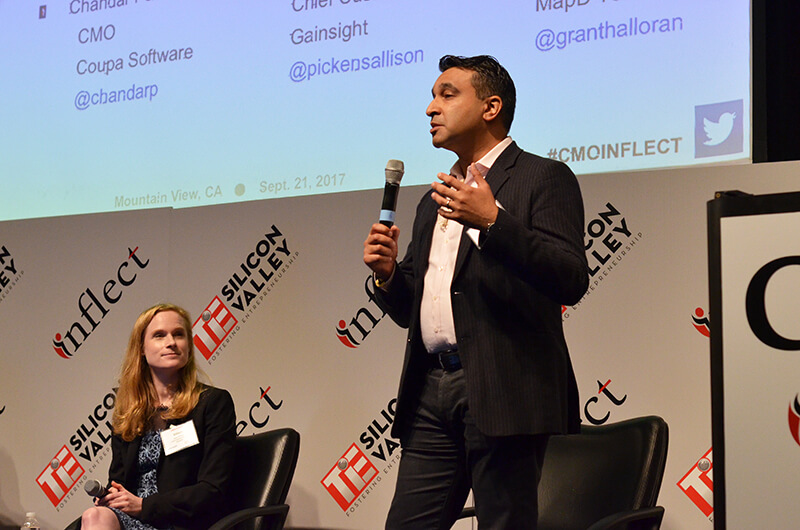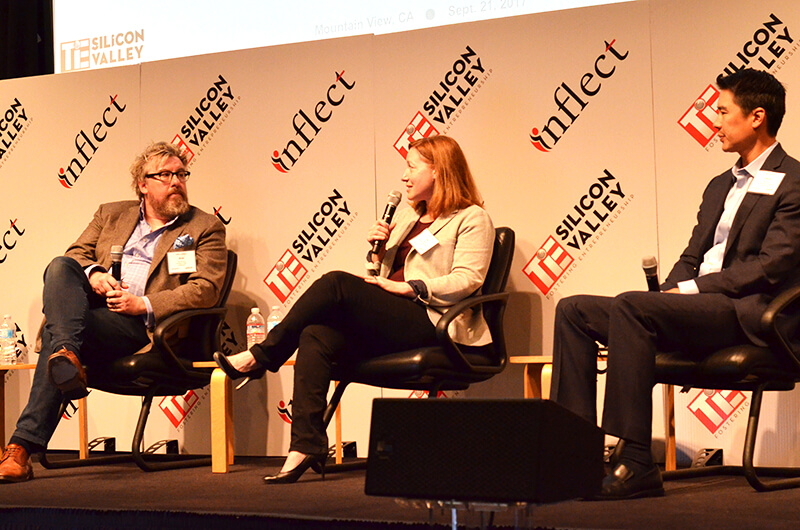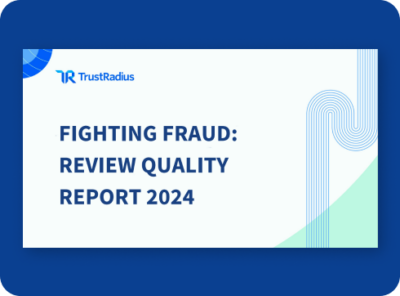
CMO Inflect: 5 key takeaways on marketing with art and science
On Sept. 21, over 350 marketing executives gathered at the Computer History Museum for TiE Silicon Valley’s CMO Inflect. The event focused on balancing the art and the science of marketing as the buyer’s journey continues to change at a rapid pace. “While the science is helping us be more precise, there is going to be a resurgence in the art of marketing,” said Manish Gupta, conference chair and CMO at Redis Labs. “That emotive aspect of the company needs to be led by the CMO across the board.”
In almost every session, two themes rose to the top as key priorities: empowering humans with data, and also empowering data with humans. The speakers included celebrity CMO Jeffrey Hayzlett, TrustRadius founder and CEO Vinay Bhagat, Coupa CMO Chandar Pattabhiram, Alfresco CMO Sydney Sloan, Palo Alto Networks CMO René Bonvanie, MapD CMO Grant Halloran and more of tech’s most innovative marketing executives. Here are five of the key takeaways from the event.
“Don’t wear it as a badge of courage that you fail fast. Yes, you are going fail, but then you want to win fast.” – Jeffrey Hayzlett, @JeffreyHayzlett
Jeffrey Hayzlett, founder of the C-Suite Network and former CMO of Kodak, kicked off the conference with a rousing session on Marketing To Win. For Hayzlett, success boils down to a willingness to take risks, and how you react when those risks don’t play out as expected. He shared a story of Kodak deciding to take their ink technology and get into printers. Unlike other companies that sold the printer at below cost but significantly upcharged for the ink, their plan was to charge a fair price for the printer and then sell the ink for half the price of their competitors.
“Ink is outrageously expensive, far more expensive than oil — it would cost you $462,000 to fill up your car with ink,” said Hayzlett. “We were in a fight against Big Ink, and we realized we had to poke them in the eye, show consumers the notorious decadence of a model where the leading ink company makes $90 billion a year.”
Because their best users were creatives who liked to go to movie theaters, Hayzlett’s team decided to launch a mobile campaign that was activated through ads that ran before the movie started, where people would be prompted to send a text to get a Kodak coupon code. The ad itself featured Soprano’s actor Vinny Pastore taking a competitor’s printer out of the trunk of his Cadillac, destroying it with a baseball bat, then welcoming a Kodak printer to the family. The edgy campaign cost millions of dollars — and only generated two texts the weekend it launched.
When he asked the team to explain what happened, one person raised their hand and said that people turn their phone off in movie theaters. Hayzlett was struck that someone in the room had realized there was a fatal flaw in the campaign, yet they didn’t speak up because the CMO was so invested in the idea. In response, he turned to his team and said, “No one died. We fucked up, but no one died. And now we have a great asset, so what are we going to do with it?”
Ultimately Kodak retooled the ad into a digital campaign, and it ended up being a huge success. For Hayzlett, it was proof that taking big risks in marketing is worth it, especially if you are willing to quickly change directions. “You are going to make mistakes, just know that,” he concluded. “But don’t wear it as a badge of courage that you fail fast. Yes, you are going fail, but then you want to win fast.”
“There really is no difference between B2B and B2C, it is all people-to-people.” – Grant Halloran, @granthalloran
Up next, TrustRadius founder and CEO Vinay Bhagat moderated a panel on Accelerating Growth With Your Customer’s Voice. Featuring two Chief Marketing Officers and one Chief Customer Officer, the panel started out by tackling the role of trust and authenticity in the B2B purchasing process.
“People process things emotionally before they process them rationally,” said Grant Halloran, CMO of MapD and former CMO of Anaplan. “Trust is huge, and it is also one of the most difficult things to gain. Our buyers have a lot to lose with these decisions — nothing else you do is worth it if you can’t get trust first.”
Chandar Pattabhiram, CMO of Coupa and former CMO of Marketo, added, “There are so many buzzwords in B2B marketing today. What is really happening is we’re borrowing from B2C and trying to humanize marketing. You must figure out how to bring authenticity into the B2B world, and the voice of your customer is a critical part of doing that.”
The conversation shifted to how marketers can foster authenticity through their customer’s voice, and why reviews in particular are a powerful way to accomplish that.
“I’ve spent most of my career working at disruptive companies, trying to overcome the disappointments of the big guy’s software, because no offense but a lot of of enterprise software sucks,” said Halloran. “These days when you Google a product, reviews are often at the top of the page. I started to notice that if a review link came up alongside the .com, I’d always click on reviews, because I was more interested in what users had to saw. When I was at Anaplan, I realized that this was an opportunity as part of our disruption strategy — because their software sucks, and ours is awesome, and I want my customers to tell that story. So reviews became a very large weapon in our arsenal.”
“When it comes to reviews, there is an efficiency argument to make in addition to an effectiveness argument,” added Allison Pickens, CCO at Gainsight. “It is more scalable to have your customers write case studies for you, than for you to do it with them.”
At Gainsight, creating concrete goals around has also been a critical component of scaling authenticity and advocacy. Since both the customer success and customer marketing functions fall under Pickens, she has been able to align goals and optimize output across her teams.
“Authenticity is critical, and it is really important to proactively prompt that authenticity,” she said. “We now have a metric called CSQA, customer success qualified advocacy. It is officially part of the CSM’s job to drive advocacy, such as a review or case study. Once we introduced this measure, it resulted in doubling of advocacy activities quarter-over-quarter.”
Pattabhiram agreed on the importance of customer-centric metrics. “There are only two metrics that matter in SaaS — lifetime value and number of brand advocates your create,” he said. “There is still this emphasis on acquisition metrics in marketing. But if a customer stays with you and can influence other customers as an advocate, that is incredibly valuable. It is a mental shift that we need to make as marketers, and that we have to help our CEOs and boards embrace.”

“You better tell people exactly what they want to hear, not what you want to tell them.” – René Bonvanie, @renebonvanie
Authentically engaging with buyers and customers was a big theme during the session on Go-To-Market Lifecycle Marketing as well. Despite selling very technical B2B solutions, all three executives on the panel stressed that how you communicate is just as important as what you communicate.
“I’m in a B2B business — we sell boring things to boring people,” joked René Bonvanie, CMO of Palo Alto Network. “You have to make a human connection that inspires a positive reaction. The math can help you target where you want to do that, but it has got be humanized, or you will fall into the trap of being a boring-to-boring business.”
David Hsieh, SVP Marketing at Qubole, described his model as an hourglass rather than a funnel, with marketing playing a significant role in adoption, expansion and enlistment. His team has the advantage of driving their hourglass model through Qubole’s own autonomous data platform, but he admits that adding authenticity to AI-driven marketing is challenging. “The trick is, how do we take this wealth of information and turn it into something that is interesting, that can reach the left and the right brain, and most importantly isn’t creepy? We’re very insight rich, and we need to turn those insights into a scalable machine, but we also must humanize as well as we can. We walk that line between friend and stalker.”
“Consistency is our worst enemy, because consistency suggests that we should tell the same story to everyone, and that is dead wrong,” said Bonvanie. “Now, you cannot be a different company with a different value proposition for each customer, it doesn’t work that way. But what is important is the translation of the science you use — the data mining, the predictive creepy stuff, all that. How do you respond to that data, what do you tell them and in what voice?”
Richard Heitmann, VP Marketing at Aspera, agreed. “We need to be able to describe the value the offering delivers in terms that the customer understands by industry,” he said. “For example, we can help a studio move all their dailies to the post-house, and in that instance the data is called content. But if you are a life sciences researcher trying to cure cancer and you need share genome sequences, if we told you we could help you move your content, you’d scratch your head.”
“Communicate at the right level and in the right voice,” concluded Bonvanie. “Never have the CEO involved in the messaging, and keep the product guys a littler further away from your customers than you want to. Instead hire practitioners, hire folks like them that speak like them. Because whether a customer is brand new or has already bought a million dollars and you want them to spend the next million, you better tell people exactly what they want to hear, not what you want to tell them.”
“Only 30% of the sales cycle is about us and what we do, 70% is about how the data flows and works with our stack.” – Nick Edouard, @nickedouard
The session on marketing technology, moderated by Leadspace CEO Doug Bewsher, revolved around data. The three panelists all stressed the importance of the information created by and running through their stack — more so than the products in their stack.
“I make sense of the marketing technology eye chart from a data perspective,” said Nick Edourad, co-founder and CMO at LookBookHQ. “The first wave of marketing technology was marketing automation platforms like Marketo. They really dealt in binary data — visits, clicks, form fills — it either did or did not happen. Since then we’ve had subsequent waves like ABM, which adds to the data set and brings forward the anonymous users. Then we’ve had a rise in predictive, looking to the web to source big data around intent and behavior. But to me the fourth category is the most interesting, which is all about how people are engaging with my content, and more importantly the quality of those interactions — not just did it happen, but was it successful. Because our job as marketers is really quite simple at its core. We need to get a high volume of people to engage with a high volume of content in a meaningful way as quickly as possible. And if we can do that, we will generate a high volume of marketing qualified leads, with an emphasis on the Q because they will be qualified.”
That focus on data means how the technology fits together is a crucial concern. This was especially evident when Alix Hart, Global Head of Digital Marketing at NVIDIA, explained her approach to analyzing new tools.
“I’ve made a real shift over the past five years into thinking about integration as the first and most important criteria in evaluating our marketing stack,” said Hart. “Today, integration and how the data stitches together, so you can serve the right message at the right time to the right person, is everything. Maybe every part of the stack isn’t best-in-breed, but it works because it can bring the data together.”
NVIDIA took that dedication to data a step further by building their own data platform, nicknamed Voltron in a nod to the super robot composed of five smaller robots. “We had this issue where we had islands of awesomeness around the organization — there was lots of data, but it was sitting in silos across many different teams,” Hart explained. “We wanted to bring the best of that awesomeness together into one platform, so we could better understand our users and make that data available for marketing.”
But even during a session on technology and data, the human element was an important part of the conversation.
“The ability to tell a story around the data is a key skill I look for when I’m building a team,” said David Hsu, VP of Marketing Technology and Demand Analytics at CA Technologies. “The number one thing I realize in my role is that it is a thankless job — you can spit out all the reports people ask for, and they will keep asking for more. So the people who have the ability to translate that technical knowledge into business speak, who can explain complex data in a manner marketers understand, is gold.”

“You need to bridge the gaps between impressions and closed deals, then revisit that continuously.” – Steven Wastie, @swastie
In the final session of the day, Engagio CMO Heidi Bullock moderated a panel on Marketing As A Revenue Driver. As Origami Logic CMO Steven Wastie put it, “It is pretty safe to say that traditionally the sales team has not viewed marketing a revenue driver. But that is changing with try-and-buy and the evolving buyer’s journey.”
All of the CMOs agreed that culture is the most important aspect of ensuring marketing plays the right role, and is recognized for their role, in revenue generation.
“We brought sales and marketing together so that we’re tightly joined at the hip,” said Wastie. “This provided absolute clarity on the buyer’s journey and how seamless it is. We wanted to break the silos and ensure it was frictionless.”
Rick Schultz, CMO at Databricks, added, “Shared accountability is key, but how you build the team is also super important.” He looks for three general attributes when hiring revenue-focused marketers:
- Super collaborative. “To achieve aggressive pipeline goals, you need to have people who really enjoy working with sales. They have to be engaging with sales regularly to make sure they are achieving those shared goals.”
- Ambitious and aggressive goal setters. “You can easily make the data say what you want it to say and sandbag to set easy goals. That’s no fun because then you end up building an average marketing machine, and none of us want to be average.”
- Analytic thinkers. “Once you set an aggressive goal, you’ve got to think about all the ways you can achieve that goals. So you want people who are asking the right kind of questions and thinking about things a little differently.”
Alfresco CMO Sydney Sloan also stressed that in addition to cohesion across team, the data also needs to be aligned. “When we think about go-to-market, we think about marketing, sales and customer success together,” she said. “We’ve connected our systems, which are Marketo and Salesforce, and now we run off the same data. We actually have our sales analysts and marketing analysts sitting together. You need to have that shared view on reporting and metrics.”
Sloan acknowledged that even with common goals and data, it can take some extra effort to keep teams aligned. She shared the story of a recent campaign focused on moving upmarket from programmers to the C-suite. Marketing committed to targeting a certain number of executive meetings, but six weeks in they realized that the C-suite leads were still sitting in queues untouched. “We put together a task force to define a combined effort for how sales and marketing together would follow up with these leads. We now have sophisticated multi-touch program with weekly reporting, and we’re on track having upwards of 10 meetings a week. The rigor and collaboration we’re applying is the key lesson here.”
Bonus Quote: “B2B needs to shift from boring-to-boring to human-to-human, but it also needs to become human-to-machine-to-human.” – John Ellet, @jellett
John Ellett, the founder and CEO of nFusion, presented a fascinating session on AI in marketing. In addition to explaining where marketing currently is in the AI journey, he provided a preview of the next stage.
“Orchestration AI is the the ability for the systems to do what humans can’t do,” he said. “It is holy grail of where we’re trying to get with AI — the personalization at scale, the one-to-one marketing, truly engaging with an individual as an individual.”
Ellett outlined six actionable steps marketers need to take to prepare for orchestration AI.
- Set thoughtful objectives. It is especially important to understand tradeoffs when working with AI, and a lot of marketers need to work on this skill.
- Connect the data dots. All your systems need to work together to ensure AI has the opportunity to execute and improve in the right direction.
- Interconnect the marketing stack. In the beginning, decide what is your hub and what your the spokes, and how the data flows between them.
- Create content objects. To all AI platforms to optimize multiple channels, you need to create individual parts that the system can assemble versus complete objects.
- Codify the brands. While brand is often interpreted by humans today, it needs to be consistently encoded and trained for AI. This should already be best practice for training non-marketers such as sales and customer service.
- Close the loop. AI needs feedback to improve, so getting information back into the system is a hard but necessary problem to tackle.
In conclusion, Ellet said the primary takeaway was that AI is coming fast, and CMOs need to focus on the infrastructure, process and people they need to take advantage of this new wave. That advice could apply to all the sessions at CMO Inflect, and how today’s top marketing executives are finding the right balance between human and data elements to achieve success.




